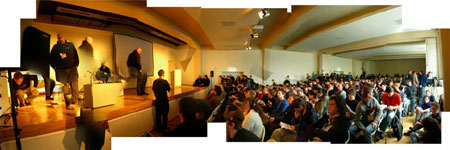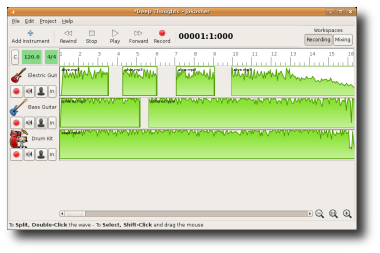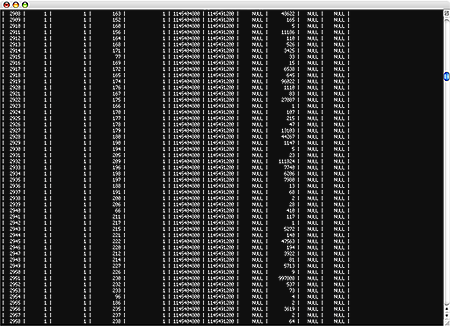Update: Just found a nice (and brief!) introduction to the Chaos Communication Congress at 46halbe.org, just in case any of the following sounds like noise to you.
The congress layout for 23C3 is fixed, and we're starting to plan the details. One important part of this is finding Heralds: volunteers who for a couple of hours are willing to be the main spokesperson in a conference room, who announce the individual sessions, and help out when something goes wrong.
This year we would like to have a Herald for every single talk, not just the big ones in Saal 1. That's quite an ambitious goal (our Herald schedule is comprised of 44 shifts), so we need lots of volunteers!
The job of a Herald is quite simple -- main barrier of entry is that you don't freak out when you have to introduce a lecture in English in front of a potentially huge crowd... And of course it's an incredible opportunity to meet some really interesting people at Europe's largest hacker conference!
For details and a schedule see the Heralds Wiki page. We're going to have a preliminary meeting to brief our Heralds, so watch the CCC Events blog for updates.
If you're interested you can claim a shift by entering your name in the Heralds schedule on our wiki page -- and feel free to contact me in case there are questions.
Since I got my PowerBook early last year I'm on the search for decent alternatives to some of the applications I was using on the PC. Thanks to a flourishing development community I found replacements for the most important stuff (and more), but one thing that is still missing is a decent multi-track audio editor suitable for music production.
I've been using Samplitude on the PC for the last couple of years, which after a brief learning curve turned out to be perfect for my needs -- it offers quite elegant means of editing audio, including non-destructive filters and timestretching on individual audio clips, a versatile approach to editing volume envelopes of samples and tracks, and a very keyboard-friendly interface. MIDI support was lacking on the versions I used, but I didn't really care as most of the stuff I'm interested in happens in the audio domain.
On the Mac side of things, at least from my perspective, the software offerings look rather bland. I can't bring myself to use the bloated and ancient Logic or Cubase interfaces, but briefly flirted with an early version of Soundtrack Pro (which turned out to be both too unstable and too demanding for screen space for my meager 12" screen), was both delighted and disappointed with Digital Performer (not really suitable if you're making many copies of small sound snippets and plan to edit each of them individually), and even found myself using Audacity, the only free offering on the Mac that I know of that is still in development, and (until now) my secretly most favoured competitor of the bunch.
But man, does Audacity suck. I would be really happy to cope with some quirks as long as the basics are taken care of, but the dev team does not seem to grasp the basics of good interface development. Reminds you of the infamous Gimp interface (whose developers actively discourage attempts to improve the UI, cf. the GimpShop story). My secret wish still is that someone gives Audacity the Firefox treatment (clean up the UI and discard the unnecessary), but that doesn't seem to be on the horizon. So I'm patiently waiting for 1.3 to be stable enough to at least have a decent multi-track editor that gets rid of some of the existing limitations (it introduces the notion of audio clips, among other things).
An Unexpected Competitor
A couple of days ago, while researching Cairo, I found an exciting new open source multitrack audio editor that seems much more interesting: Jokosher! It not only has a great looking interface, but it already seems to spark innovative side-projects, and it's quite apparent that many people are getting excited about finding such a promising open source offering, so it's safe to say that this project is going to become quite popular within the next 1-2 years.
Jokosher has a range of features that make it really interesting for music production: Not only does is provide a well-designed multitrack audio editor, it also supports LADSPA effects, an extensions API, and more... which is amazing for such an early release.
The pitfall: it's developed on Linux, which means we'll have to wait for someone to port it to OS X...
(Jonty then also pointed me to the Diva Video Editor project, which looks like the equivalent hungry leftfield offering for simple video editing -- looks interesting!)
The Jokosher preview 0.2 will be released on November 20th.
Links
Related Articles
I was searching for a fast and modern graphing framework for server-side image generation (ImageMagick == too much hassle, too many weird dependencies, bitch to set up on OS X) and found Cairo, which looks like a great alternative.
It's used for the GNOME desktop environment, and Mozilla will use it for various rendering tasks in their Gecko browser engine, but it also has bindings to most important scripting languages (notably Ruby and Python), almost no dependencies, generates PNG images out-of-the box, and seems quite well-designed.
Links
(From my Last.fm journal)
A little while ago I implemented another visualization roughly based on Martin Wattenberg's arc diagrams. It's a visualization of a person's weekly Last.fm charts, designed to convey how your listening behaviors change over time, and also (just because it's really easy to determine) the mainstream-ness of your taste. The previous data visualization I had called IRC Arcs, so it's only natural to call this one Chart Arcs.
I'm currently thinking about meaningful representations of a person's music listening behavior, e.g. visualizations that show aspects of your musical taste and habits, and I think that this particular visualization is quite successful in conveying a small part of that.
All Word Extinguisher
I made graphs of the Last.fm office crew, and it's interesting to compare different people's graphs -- joanofarctan has quite an obscure taste when compared to the rest (his graph has very slim arcs), my own graph shows how much I'm a fame whore in my musical taste (top chart positions are usually held by more popular artists, as the dot sizes of top chart positions show), and I quite like the graphs of of people who have a less-populated user profile, as you can see in e.g. the minimalist appeal of spencerhyman's graph.
Truffle? No, Shuffle!
I was surprised to see that some of the graphs were just hard to read random piles of data upon data, and I didn't really find an obvious explanation. See e.g. skr's big splotch. The listening behavior that resulted in those graphs didn't seem that much different from everybody else -- those were usually really active listeners, but others with a very active profile or a similar number of unique artists had very well-defined graphs.
I then started to get PMs from Last.fm users who wanted a chart arc of their profile, and it was then that a pattern emerged -- one user from Buenos Aires was wondering why his graph was fuller than some of the others, and we started to chat about his listening behavior, and it turned out that he's listening a lot in shuffle mode. I asked around in the office, and it turns out that our Last.fm colleagues with big splotches all listen in shuffle mode a lot of the time!
The resulting graphs now made sense -- "shufflers" will have a higher number of frequently recurring artists in their weekly charts when compared to "album listeners", who might might listen to a completely different set of artists from one week to the next. As we don't draw arcs when an artist leaves or enters your charts (it will only influence the coloring of the respective chart position's circle) graphs of shufflers will show much more local movement than those of album listeners.
Last.fm station of the day: Raum247's "feier-abend" tag radio. (And sorry for the very cheesy headlines...)
Links
The following text explains how to get the Linksys WUSB11 2.8 working on OS X, and probably any other wifi adapter based on an Atmel AT76c505 chipset. (Caveat: As far as I know Kismac still does not support Atmel devices.)
Short version for people who have patched wifi drivers before: try the XTerasys XN-2122B drivers linked below. (mailtomomo indicates that AIN's AWU2000B also has a driver for OS X, and they do indeed have a download labeled "Mac driver", but that only links to an .exe)
Skip the prelude if you only want the raw facts.
Prelude
London has a lot of open wifi networks, so it's a paradise for the alyways-stay-connected junkie... Unfortunately my Powerbook's wifi antenna isn't too strong, which means it's usually a hassle to get a decent and stable connection. After one too many times of such technology-induced frustrations I decided I needed a remedy, so I bought a cheap external 802.11b USB adapter, the Linksys WUSB11 v2.8.
Unfortunately setting up the device turned out to be a pain -- I had consulted several hardware lists that uniformly declared WUSB11 v2.5 and v3 to be based on a Prism2 chipset, and I assumed that the v2.8 would certainly have the same technological basis; after all, 2.8 is in between 2.5 and 3, right? Needless to say, hardware manufacturers will disagree with that. After much experimentation with modified Prism drivers I finally opened the device and found an Atmel chip inside, the AT76c505. And as every wifi FAQ will tell you, Atmel and OS X == usually a bad match.
Long story short, the at76c503a driver project has a detailed list of AT76c50x wifi devices, which includes several devices based on the AT76c505, so I simply tried to find OS X drivers for every device listen on that page.
Howto
If you've never patched a driver before it may be helpful to check out the OS X wifi driver patching howto on mcquitty.net -- it's for a different chipset, but the overall approach is the same.
Step-by-step:
- Get your device's vendor and product ID from System Profiler (mine: vendor=0x1915, product=0x2233)
- If they're in hex: convert to decimal, e.g. with Calculator (mine: vendor=6421, product=8755)
- Download the OS X driver for the XTerasys XN-2122B USB stick
- it comes with three versions of the driver and configuration application (10.1, 10.2 and 10.3) -- I used the 10.3 versions
- open the DriverSetup.pkg bundle of your driver, open the Contents folder in Terminal, then run gunzip Archive.pax.gz
- open Archive.pax in a hex editor of your choice -- I use Hex Fiend
- search for the first occurrence of idProduct, replace the numeric value with the decimal product ID of your adapter; make sure not to change the overall file length (this is a binary file!) -- e.g. pad with zeros if your ID is shorter
- do the same for the first occurrence of idVendor
- re-pack the file with gzip Archive.pax
- now you can install your patched driver
- after rebooting go to System Preferences, open the Network panel, you should get a "new device found" message
- install XTerasys' config application (a rudimentary setup tool called WatlanX) and run it to connect to your network
Links
A couple of weeks ago my ISP apparently added Apache support for Ruby scripts, which they didn't provide until recently. Which is great news, but had an unfortunate side-effect: All download links to Ruby scripts on this domain broke, as Apache tried to execute them instead of presenting them in text/plain, but failed because none of the files had the executable bit set (and aren't meant to be executed anyway). A classic moment of naive assumptions on my side -- I should have anticipated that Ruby support is becoming a popular request for hosting providers these days.
Due to me having moved to London and starting a new job I was too busy to take care of that; there was a weekend a while ago when I tried to sweet-talk .htaccess to not treat .rb files as CGI scripts, but failed.
I don't remember exactly what I tried to do, but here's the commented-out remainder in my .htaccess file:
# don't execute ruby scripts
#AddHandler default-handler .rb
#RemoveHandler .rb
#AddType text/plain .rb
...so I was probably trying combinations of these three lines, but still got 403s. (Does someone know how to do this correctly? I.e., how to instruct Apache to serve .rb files as plaintext?)
And the polite emails about broken script downloads kept coming (which says something about the nuisance level this created -- I disabled comments for now, and it takes manual effort and more clicks to contact me than to write a comment), so today I decided to do something about it.
As I failed to configure Apache I did it the old-fashioned way: renamed all .rb files to .rb.txt, then updated the links -- not very elegant. Please let me know if I missed some scripts.
I really should set up a public SVN repository -- I have one on TextDrive that I rarely use, but I'm a little hesitant about the administration effort involved in creating a public repository next to the secure non-public repository... any tips?
I just completed a simple visualization of IRC communication behavior, you can see the graphics at mardoen.textdriven.com/irc_arcs/ -- this is the analysis of about a month's worth of IRC communication on a single channel.
I especially like irc_arcs_incoming.png (top left) -- it clearly communicates a number of interesting attributes (the strongest ties, passive recipients vs. active senders, well-balanced vs. one-sided conversations, ...)
The visualization concept is roughly based on Martin Wattenberg's arc diagrams (refer to his research page for the paper). But the semantics of these visualizations differ -- e.g., the element order of IRC arcs is not based on their sequence order in the original data.
Related Articles
I thought I should start documenting some of the places I found in London. I'm mainly moving around in the north-east, in Hackney, Islington and sometimes Camden, but I've also been to Notting Hill for the carnival (tourist fest) and of course seen the center. To me it currently seems like London shares a similar east-west divide with Berlin, in that the West is the more established, richer London, but the East is where it's at, where the interesting stuff happens. Haven't been to Brixton yet though, so there still much to explore. And while I'm exploring I'd like to share with you a random selection of the memorable places I found.
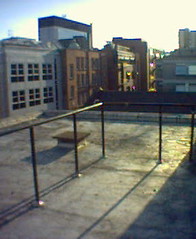 |
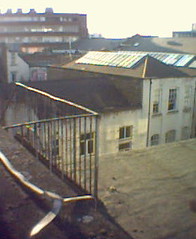 |
(Views from the office roof.) |
Once Upon a Time in Hoxton
First of all, Hoxton Square -- it's not a very exciting place per se, more of a hangout of the borderline mainstream young-professionals-and-older crowd. But it used to look quite different just a couple of years ago, when Shoreditch (I'm told) wasn't the horrible mating place of the international hipster crowd it is now.
In one of the corner buildings of Hoxton Square you'll find a café-slash-bar, "Bluu", which used to be the setting of a quite famous club called Blue Note. They hosted, among others, the monthly Metalheadz label night in the mid-90ies. I've been there once, around 1996 (?), with a couple of friends. One friend got the tip by a shoe salesgirl who showed us how to get there with a tube map, and walking the then-deserted roads of Shoreditch/Hoxton was quite a different experience than it is now. And yet it turned out to become one of the most memorable nights ever... Amazing mixture of music (I distinctly remember a sped-up mix of some "3 Feet"-era De La Soul track), and a really great crowd.
Sadly this was pre-omniscient Internet, so it may be impossible to find out who was playing that particular night. But I found an informative reminiscence of a long-gone more racially mixed pre-hipster Hackney on the Samar Magazine website, with a few sentences about Blue Note in the first paragraph: Once Upon a Time in Hoxton.
Oblig Pop
Last.fm tag of the day: officially shit. Great bird's eye view on the current state of major label pop. See also razo9's indignant commentary on hater tags: "I have to say, the officially shit radio is some of the best listening in last.fm."
